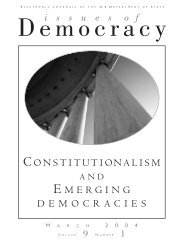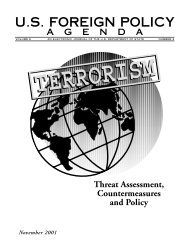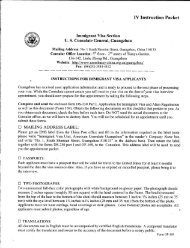s. history us history us history - Embassy of the United States
s. history us history us history - Embassy of the United States
s. history us history us history - Embassy of the United States
- No tags were found...
You also want an ePaper? Increase the reach of your titles
YUMPU automatically turns print PDFs into web optimized ePapers that Google loves.
CHAPTER 15: BRIDGE TO THE 21ST CENTURYOUTLINE OF U.S. HISTORYhowever, Oslo eventually fell apartwhen details were disc<strong>us</strong>sed. Palestinianleader Yasser Arafat rejectedfinal <strong>of</strong>fers from peace-minded Israelileader Ehud Barak in 2000 andJanuary 2001. A full-scale Palestinianinsurgency, marked by <strong>the</strong> <strong>us</strong>e<strong>of</strong> suicide bombers, erupted. Barakfell from power, to be replaced by<strong>the</strong> far tougher Ariel Sharon. U.S.identification with Israel was consideredby some a major problemin dealing with o<strong>the</strong>r issues in <strong>the</strong>region, but American diplomatscould do little more than hope tocontain <strong>the</strong> violence. After Arafat’sdeath in late 2004, new Palestinianleadership appeared more receptiveto a peace agreement, and Americanpolicy makers resumed effortsto promote a settlement.President Clinton also becameclosely engaged with “<strong>the</strong> troubles”in Nor<strong>the</strong>rn Ireland. On one sidewas <strong>the</strong> violent Irish RepublicanArmy, supported primarily by thoseCatholic Irish who wanted to incorporate<strong>the</strong>se British counties into <strong>the</strong>Republic <strong>of</strong> Ireland. On <strong>the</strong> o<strong>the</strong>rside were Unionists, with equally violentparamilitary forces, supportedby most <strong>of</strong> <strong>the</strong> Protestant Scots-Irishpopulation, who wanted to remainin <strong>the</strong> <strong>United</strong> Kingdom.Clinton gave <strong>the</strong> separatistsgreater recognition than <strong>the</strong>y everhad obtained in <strong>the</strong> <strong>United</strong> <strong>States</strong>,but also worked closely with <strong>the</strong>British governments <strong>of</strong> John Majorand Tony Blair. The ultimate result,<strong>the</strong> Good Friday peace accords <strong>of</strong>1998, established a political processbut left many details to beworked out. Over <strong>the</strong> next severalyears, peace and order held betterin Nor<strong>the</strong>rn Ireland than in <strong>the</strong>Middle East, but remained precario<strong>us</strong>.The final accord continued toelude negotiators.The post-Cold War disintegration<strong>of</strong> Yugoslavia — a state ethnicallyand religio<strong>us</strong>ly divided amongSerbs, Croats, Slovenes, BosnianM<strong>us</strong>lims, and Albanian Kosovars— also made its way to Washingtonafter European governmentsfailed to impose order. The B<strong>us</strong>hadministration had ref<strong>us</strong>ed to getinvolved in <strong>the</strong> initial violence;<strong>the</strong> Clinton administration finallydid so with great reluctance afterbeing urged to do so by <strong>the</strong> Europeanallies. In 1995, it negotiatedan accord in Dayton, Ohio, to establisha semblance <strong>of</strong> peace inBosnia. In 1999, faced with Serbianmassacres <strong>of</strong> Kosovars, it led athree-month NATO bombing campaignagainst Serbia, which finallyforced a settlement.In 1994, <strong>the</strong> administration restoredo<strong>us</strong>ted President Jean-BertrandAristide to power in Haiti,where he would rule for nine yearsbefore being o<strong>us</strong>ted again. The interventionwas largely a result <strong>of</strong>Aristide’s carefully cultivated supportin <strong>the</strong> <strong>United</strong> <strong>States</strong> and Americanfears <strong>of</strong> waves <strong>of</strong> Haitian illegalimmigrants.In sum, <strong>the</strong> Clinton administrationremained primarily inwardlooking, willing to tackle internationalproblems that could not beavoided, and, in o<strong>the</strong>r instances,forced by <strong>the</strong> rest <strong>of</strong> <strong>the</strong> worldto do so.INTIMATIONS OF TERRORISMNear <strong>the</strong> close <strong>of</strong> his administration,George H. W. B<strong>us</strong>h sentAmerican troops to <strong>the</strong> chaotic EastAfrican nation <strong>of</strong> Somalia. Theirmission was to spearhead a U.N.force that would allow <strong>the</strong> regularmovement <strong>of</strong> food to a starvingpopulation.Somalia became yet ano<strong>the</strong>rlegacy for <strong>the</strong> Clinton administration.Efforts to establish a representativegovernment <strong>the</strong>re becamea “nation-building” enterprise. InOctober 1993, American troopssent to arrest a recalcitrant warlordran into unexpectedly strong resistance,losing an attack helicopterand suffering 18 deaths. The warlordwas never arrested. Over <strong>the</strong>next several months, all Americancombat units were withdrawn.From <strong>the</strong> standpoint <strong>of</strong> <strong>the</strong> administration,it seemed prudentenough simply to end a marginal,ill-advised commitment and concentrateon o<strong>the</strong>r priorities. It onlybecame clear later that <strong>the</strong> Somalianwarlord had been aided by a shadowyand emerging organization thatwould become known as al-Qaida,headed by a fundamentalist M<strong>us</strong>limnamed Osama bin Laden. A fanaticalenemy <strong>of</strong> Western civilization,bin Laden reportedly felt confirmedin his belief that Americans wouldnot fight when attacked.By <strong>the</strong>n <strong>the</strong> <strong>United</strong> <strong>States</strong> hadalready experienced an attack byM<strong>us</strong>lim extremists. In February1993, a huge car bomb was explodedin an underground parking garagebeneath one <strong>of</strong> <strong>the</strong> twin towers <strong>of</strong><strong>the</strong> World Trade Center in lowerManhattan. The blast killed sevenpeople and injured nearly a tho<strong>us</strong>and,but it failed to bring down <strong>the</strong>huge building with its tho<strong>us</strong>ands <strong>of</strong>workers. New York and federal authoritiestreated it as a criminal act,apprehended four <strong>of</strong> <strong>the</strong> plotters,and obtained life prison sentencesfor <strong>the</strong>m. Subsequent plots to blowup traffic tunnels, public buildings,and even <strong>the</strong> <strong>United</strong> Nations wereall discovered and dealt with in asimilar fashion.Possible foreign terrorism wasnone<strong>the</strong>less overshadowed by domesticterrorism, primarily <strong>the</strong>Oklahoma City bombing. The work<strong>of</strong> right-wing extremists TimothyMcVeigh and Terry Nichols,it killed 166 and injured hundreds,a far greater toll than <strong>the</strong> 1993Trade Center attack. But on June 25,1996, ano<strong>the</strong>r huge bomb explodedat <strong>the</strong> Khobar Towers U.S. militaryho<strong>us</strong>ing complex in Saudi Arabia,killing 19 and wounding 515. A federalgrand jury indicted 13 Saudisand one Lebanese man for <strong>the</strong> attack,but Saudi Arabia ruled out anyextraditions.Two years later, on Aug<strong>us</strong>t 7,1998, powerful bombs explodingsimultaneo<strong>us</strong>ly destroyed U.S. embassiesin Kenya and Tanzania, killing301 people and injuring more330331












